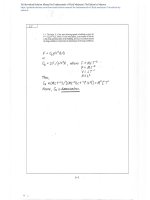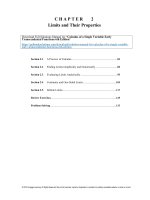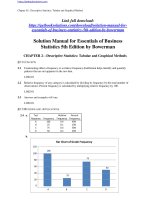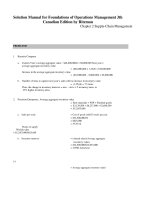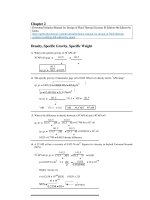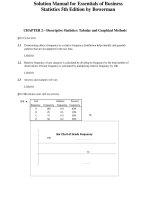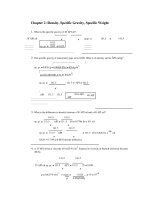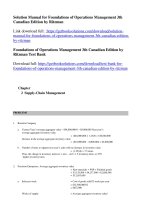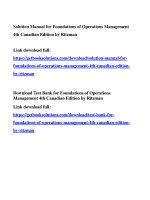Solution manual for calculus of a single variable early transcendental functions 6th edition sample
Bạn đang xem bản rút gọn của tài liệu. Xem và tải ngay bản đầy đủ của tài liệu tại đây (3.02 MB, 69 trang )
CHAPTER
2
Limits and Their Properties
Download Full Solutions Manual for “Calculus of a Single Variable Early
Transcendental Functions 6th Edition”
/>
Section 2.1
A Preview of Calculus ...........................................................................81
Section 2.2
Finding Limits Graphically and Numerically ....................................82
Section 2.3
Evaluating Limits Analytically ............................................................93
Section 2.4
Continuity and One-Sided Limits ......................................................105
Section 2.5
Infinite Limits .......................................................................................117
Review Exercises ..........................................................................................................125
Problem Solving............................................................................................................133
© 2015 Cengage Learning. All Rights Reserved. May not be scanned, copied or duplicated, or posted to a publicly accessible website, in whole or in part.
C H A P T E R 2 Limits and
Their Properties
Section 2.1
A Preview of Calculus
1. Precalculus: (20 ft/sec)(15 sec) = 300 ft
2. Calculus required: Velocity is not constant.
7. f (x ) = 6x − x
y
(a)
2
10
Distance ≈ (20 ft/sec)(15 sec) = 300 ft
8
P
6
3. Calculus required: Slope of the tangent line at x = 2 is
the rate of change, and equals about 0.16.
x
4. Precalculus: rate of change = slope = 0.08
1
(b) Calculus required: Area = bh
≈ 2( 2.5)
= 5 sq. units
(a)
2
4
1
5. (a) Precalculus: Area = 2 bh = 2 (5)(4) = 10 sq. units
6. f (x ) =
−2
(b)
slope = m =
8
(6x − x 2 ) − 8 = ( x − 2)( 4 − x)
x−2
For x = 3, m = 4 − 3 = 1
For x = 2.5, m = 4 − 2.5 =
x
x−2
= ( 4 − x ), x ≠ 2
1.5 =
y
For x = 1.5, m = 4 − 1.5 = 2.5 =
P(4, 2)
2
5
3
2
2
(c) At P(2, 8), the slope is 2. You can improve your
approximation by considering values of x close to 2.
8. Answers will vary. Sample answer:
x
1
2
3
4
5
The instantaneous rate of change of an automobile’s
position is the velocity of the automobile, and can
be determined by the speedometer.
x−2
x−4
(b) slope = m =
x−2
=
=
x = 1: m =
( x + 2)(
1
x+2
1
x−2
,x≠4
=
1
x = 3: m =
1+2
3
1
3 + 2 ≈ 0.2679
x = 5: m =
1
5+2
(c) At P(4, 2) the slope is
)
≈ 0.2361
1
1
=
= 0.25.
4+ 2
4
You can improve your approximation of the slope
at x = 4 by considering x-values very close to 4.
© 2015 Cengage Learning. All Rights Reserved. May not be scanned, copied or duplicated, or posted to a publicly accessible website, in whole or in part.
81
82
Chapter 2
Limits and Their Properties
5
5
5
9. (a) Area ≈ 5 + 2 + 3 + 4 ≈ 10.417
1
5 5
5 5
5 5
5
Area ≈ 2 5 + 1.5 + 2 + 2.5 + 3 + 3.5 + 4 + 4.5
(
) ≈ 9.145
(b) You could improve the approximation by using more rectangles.
( 5 − 1) 2
(2)
10. (a) D1 =
2
(b) D =
1+
5
2
+ ( 1 − 5)
2
(2
+ 1+
5
3
−
16 + 16 ≈ 5.66
=
(3
)
5
2
+
5
1+
4
−
(4 )
)
5
2
+ 1+
5
−1
2
≈ 2.693 + 1.302 + 1.083 + 1.031 ≈ 6.11
(c) Increase the number of line segments.
Section 2.2
1.
x
3.9
3.99
3.999
4.001
4.01
4.1
f (x)
0.2041
0.2004
0.2000
0.2000
0.1996
0.1961
x−4
lim
2
1
Actual limit is
.
5
x
–0.1
–0.01
–0.001
0
0.001
0.01
0.1
f (x)
0.5132
0.5013
0.5001
?
0.4999
0.4988
0.4881
≈ 0.5000
Actual limit is
x+1−1
lim
3.
≈ 0.2000
− 3x − 4
x→4x
2.
Finding Limits Graphically and Numerically
1
.
x→ 0
x
2
x
–0.1
–0.01
–0.001 0.001
0.01
0.1
f (x)
0.9983
0.99998
1.0000 1.0000
0.99998
0.9983
lim sin x ≈ 1.0000
x→ 0 x
4. x
f (x)
( Actual limit is 1.) ( Make sure you use radian mode.)
–0.1
–0.01
–0.001 0.001
0.01
0.1
0.0500
0.0050
0.0005 –0.0005
–0.0050
–0.0500
lim cos x − 1 ≈ 0.0000
x
x→ 0
5. x
f (x)
–0.1
–0.01
–0.001 0.001
0.01
0.1
0.9516
0.9950
0.9995 1.0005
1.0050
1.0517
x
lim e − 1 ≈ 1.0000
x
x→ 0
6. x
f (x)
( Actual limit is 0.) ( Make sure you use radian mode.)
( Actual limit is 1.)
–0.1
–0.01
–0.001 0.001
0.01
0.1
1.0536
1.0050
1.0005 0.9995
0.9950
0.9531
lim ln ( x + 1 ) ≈ 1.0000
x
x→ 0
( Actual limit is 1.)
© 2015 Cengage Learning. All Rights Reserved. May not be scanned, copied or duplicated, or posted to a publicly accessible website, in whole or in part.
Section 2.2 Finding Limits Graphically and Numerically
7.
x
0.9
0.99
0.999
1.001
1.01
1.1
f (x)
0.2564
0.2506
0.2501
0.2499
0.2494
0.2439
x−2
lim
x →1
8.
2
–4.1
–4.01
–4.001
–4
–3.999
–3.99
–3.9
f (x)
1.1111
1.0101
1.0010
?
0.9990
0.9901
0.9091
x+4
x + 9x + 20
f (x)
lim
x →1
x4
0.9
0.99
0.999
1.001
1.01
1.1
0.7340
0.6733
0.6673
0.6660
0.6600
0.6015
−1
6
≈
0.6666
2
Actual limit is
.
−1
x
10. x
f (x)
x3
lim
x → −3
3
–3.1
–3.01
–3.001
–3
–2.999
–2.99
–2.9
27.91
27.0901
27.0090
?
26.9910
26.9101
26.11
( Actual limit is 27.)
+ 27 ≈ 27.0000
x+3
x
–6.1
–6.01
–6.001
–6
–5.999
–5.99
–5.9
f (x)
–0.1248
–0.1250
–0.1250
?
–0.1250
–0.1250
–0.1252
10 − x − 4
lim
x
f (x)
lim
≈ − 0.1250
1
Actual limit is −
x+6
x → −6
.
8
1.9
1.99
1.999
2
2.001
2.01
0.1149
0.115
0.1111
?
0.1111
0.1107 0.1075
x (x + 1) − 2 3
≈
0.1111
Actual limit is
x−2
x→2
1
2.1
.
9
x
–0.1
–0.01
–0.001
0.001
0.01
0.1
f (x)
1.9867
1.9999
2.0000
2.0000
1.9999
1.9867
lim sin 2x ≈ 2.0000
x
x→0
14.
( Actual limit is 1.)
≈ 1.0000
2
9. x
13.
.
4
x
x → −4
12.
1
Actual limit is
+x−6
x
lim
11.
≈ 0.2500
( Actual limit is 2.) ( Make sure you use radian mode.)
x
–0.1
–0.01
–0.001
0.001
0.01
0.1
f (x)
0.4950
0.5000
0.5000
0.5000
0.5000
0.4950
lim
x→0
tan x
tan 2x
≈
0.5000
Actual limit is
1
.
2
© 2015 Cengage Learning. All Rights Reserved. May not be scanned, copied or duplicated, or posted to a publicly accessible website, in whole or in part.
83
84
15.
Chapter 2
x
1.9
1.99
f (x)
0.5129
0.5013
lim
ln x − ln 2
x→2
16.
Limits and Their Properties
≈
1.999
0.5001 0.4999
0.5000
2.01
2.1
0.4988
0.4879
1
Actual limit is
x−2
–0.1
–0.01
f (x)
3.99982
4
4
.
2
x
lim
2.001
–0.001 0.001
4
0
0.01
0
0.1
0.00018
does not exist.
x → 0 1 + e1 x
17. lim (4 − x) = 1
25. (a)
f (1) exists. The black dot at (1, 2) indicates that
x →3
18. lim sec x
f (1) = 2.
=1
(b) lim f (x) does not exist. As x approaches 1 from the
x→0
(4 − x )
19. lim f (x) = lim
x→2
x →1
=2
left, f (x) approaches 3.5, whereas as x approaches 1
from the right, f (x) approaches 1.
x→ 2
20. lim f ( x ) = lim
x→1
x →1
21. lim x − 2
x→2 x − 2
x2
(
(c) f (4) does not exist. The hollow circle at
+3 =4
)
does not exist.
(d)
x→ 4
2: lim f (x)
x−2
For values of x to the left of 2,
for values of x to the right of 2,
22. lim
4
( x − 2)
= 2.
x→4
= −1, whereas
x−2
( x − 2)
= 1.
26. (a)
f (−2) does not exist. The vertical dotted line
indicates that f is not defined at –2.
(b) lim f (x) does not exist. As x approaches –2, the
x → −2
does not exist. The function approaches
x → 0 2 + e1 x
2 from the left side of 0 by it approaches 0 from the left
side of 0.
23. lim cos(1 x) does not exist because the function
x→0
oscillates between –1 and 1 as x approaches 0.
24.
(4, 2) indicates that f is not defined at 4.
lim f (x) exists. As x approaches 4, f (x) approaches
lim tan x does not exist because the function increases
x →π 2
π
without bound as x approaches 2 from the left and
π
decreases without bound as x approaches
from
2
the right.
values of f x do not approach a specific number.
( )
(c) f (0) exists. The black dot at ( 0, 4) indicates that
f (0) = 4.
(d) lim f (x) does not exist. As x approaches 0 from the
x→ 0
left, f (x) approaches
1,
2
whereas as x approaches 0
from the right, f (x) approaches 4.
(e) f (2) does not exist. The hollow circle at
(2, 12 ) indicates that
f
( 2)
is not defined.
(f ) lim f (x) exists. As x approaches 2, f
( x ) approaches
x→ 2
1
2
: lim f (x) =
x→ 2
1
2
.
(g) f (4) exists. The black dot at ( 4, 2) indicates that
f (4) = 2.
(h) lim f (x) does not exist. As x approaches 4, the
x→ 4
values of f (x) do not approach a specific number.
© 2015 Cengage Learning. All Rights Reserved. May not be scanned, copied or duplicated, or posted to a publicly accessible website, in whole or in part.
Section 2.2 Finding Limits Graphically and Numerically
27.
< 0.01.
1
− 1=
x−1
x−1
1 . If 0 < x − 2 < 1, then
6
Let δ =
5
3
4
2
101
f
1
−2 −1
−1
−2
2−x
f(x)−1 =
32. You need
y
1 2 3 4 5
x
85
101
1
1
1
1
< x− 2<
⇒1 −
101
101
101
100
102
⇒ 101 < x − 1 < 101
−
lim f (x ) exists for all values of c ≠ 4.
x→c
⇒ x − 1 > 100
28.
101
y
−
2
and you have
1
f(x)− 1=
x
π
π
2
2
1
x−1
−1=
2−x
x−1
<
1 101
100 101
= 0.01.
π
−1
33. You need to find δ such that
lim f (x) exists for all values of c ≠ π .
0 < x − 1 < δ implies
1
f ( x ) − 1 = − 1 < 0.1. That is,
x
x→c
29. One possible answer is
−0.1 < 1 − 1 < 0.1
x
y
6
5
1 − 0.1 <
4
<
9
f
10
2
1
−2 −1
−1
1 2 3 4 5
10
x
10
30. One possible answer is
9
y
9
3
< 1 + 0.1
1
< 11
x
>
10
x >
−1>x−1 >
1 > x−1>−
9
4
1
x
So take δ =
1
1
10
11
10
−1
11
.
11
. Then 0 < x − 1 < δ implies
11
2
1
− 1
x
− 3− 2
31. You need
−1
−1
1
2
f ( x) − 3 = ( x + 1 ) − 3 = x − 2
So, take δ = 0.4. If 0
x−2
< 0.4.
< x − 2 < 0.4, then
1
11
− 1 < x − 1 < 1.
11
9
Using the first series of equivalent inequalities, you
obtain
= (x + 1) − 3 = f (x) − 3 < 0.4, as desired.
f
(x)−1=
1
x
− 1 < 0.1.
© 2015 Cengage Learning. All Rights Reserved. May not be scanned, copied or duplicated, or posted to a publicly accessible website, in whole or in part.
1
=
100
86
Chapter 2
Limits and Their Properties
(
)
x→2
34. You need to find δ such that 0 <
f ( x) − 3
x
=
−0.2 < x
2
x
x
<
So take δ =
( x + 2)( x − 2) < 0.01
x+2
< δ implies
x
x−2<
4.2 − 2.
x − 2 < δ ≈ 0.002, you have
x − 2 < 0.002 =
x+2
x − 2 < 0.01
2
)
x − 3 − 1 < 0.01
= 3(2) + 2 = 8 = L
( 3x + 2) − 8
(
< 0.01
0< x−2 <
)
2
2
38. lim x + 6 = 4 + 6 = 22 = L
3 x − 2 < 0.01
0.01
f ( x ) − L < 0.01.
x→4
3x − 6 < 0.01
≈ 0.0033 = δ
3
x−2 <δ =
0.01 ,
you have
3
( x2
+ 6) − 22 < 0.01
x2
x−4<
3 x − 6 < 0.01
−
x→6
6
−
x
= 6−
3
x
6
=4=L
3
− 4 < 0.01
3
0.01
x+4
0.01
− 8 < 0.01
f ( x ) − L < 0.01.
6
− 16 < 0.01
( x + 4)( x − 4) < 0.01
3 x − 2 < 0.01
lim
x
2−
< 0.01
3
1
− 3(x − 6) < 0.01
If you assume 3 < x < 5, then δ =
≈ 0.00111.
9
0.01
So, if 0 < x − 4 < δ ≈
, you have
9
0.01
0.01
x−4 <
<
9
x+4
( x + 4)( x − 4) < 0.01
x2
− 16 < 0.01
( x2 + 6 )
− 22 < 0.01
f ( x ) − L < 0.01.
x − 6 < 0.03
0 < x − 6 < 0.03 = δ
So, if 0 < x − 6 < δ = 0.03, you have
−
1
3
(x − 6) < 0.01
2 − x < 0.01
3
6 −
x
3
( 0.01)
x − 4 < 0.01
(
x→2
36.
1
( 0.01) < 1
5
x +2
2
(3x + 2)
(3x+2)
0.01
x+2
If you assume 1 < x < 3, then δ ≈ 0.01 5 = 0.002.
4.2 − 2
− 4 < 0.2.
2
x − 2 < 0.01
So, if 0 <
Using the first series of equivalent inequalities, you obtain
So, if 0 <
− 3 − 1 < 0.01
4.2 − 2
3.8 − 2 < x − 2 <
35. lim
2
2
=
x
< 4.2
<
4.2
x−2
f ( x) − 3
)
x − 4 < 0.01
4.2 − 2 ≈ 0.0494.
( 4.2 − 2)
(
< 4 + 0.2
2
3.8 − 2 < x − 2 <
−
2
37. lim x − 3 = 2 − 3 = 1 = L
2
x
<
Then 0 <
2
− 4 < 0.2
4 − 0.2 <
3.8
3.8
< δ implies
− 1 − 3 = x − 4 < 0.2. That is,
2
2
x−2
− 4 < 0.01
f ( x ) − L < 0.01.
© 2015 Cengage Learning. All Rights Reserved. May not be scanned, copied or duplicated, or posted to a publicly accessible website, in whole or in part.
Section 2.2
39. lim( x + 2) = 4 + 2 = 6
Finding Limits Graphically and Numerically
42. limx→3
x→4
Given ε > 0:
1=
13
(34 x + 1) = 34 ( 3) +
4 Given ε > 0:
(34 x + 1) − 134
( x + 2) − 6 < ε
x −4<ε =δ
3
= ε . So, if 0 < x − 4 < δ = ε , you have
So, let δ
3
x−4 <ε
( x + 2) − 6
<ε
40. lim ( 4x + 5) = 4(− 2) + 5 = −3
x → −2
> 0:
( 4x + 5) − (− 3)
3
9
4x− 4<ε
3
4 x + 1
4 x+2 <ε
x+2 <
ε
ε
4
x→6
ε
< δ = , you have
4
<ε
x+2
4
4x + 8 < ε
x → −4
(2
3−3<ε
0<ε
So, any δ > 0 will work. So,
for any δ > 0, you have
3−3 <ε
f ( x ) − L < ε.
f ( x ) − L < ε.
x−1 =
)
2
1
( − 4) − 1 = −3
44. lim (−1) = −1
x→2
2
Given ε
> 0:
Given ε
1
Given ε > 0:
<ε
(4x + 5) − (−3)
1
) − 134 < ε
43. lim 3 = 3
.
So, if 0 < x + 2
(
(
f(x)−L<ε.
=δ
4
41. lim
4 x−3<ε
4
x − 3 < 3ε
4
So, if 0 < x − 3 < δ = 3ε , you have
4
x − 3 < 3ε
3
4 x−3<ε
<ε
4x + 8 < ε
So, let δ =
9
4x− 4 <ε
4
So, let δ = 3ε.
f(x) − L < ε .
Given ε
> 0: −1 − (− 1) < ε
0<ε
x − 1 − ( − 3) < ε
)
1
2
1
< ε
So, any δ
x+2 <ε
> 0 will work.
So, for any δ > 0, you have
x − ( −4 ) < ε
(−1) − (−1) < ε
x − ( −4 ) < 2ε
f ( x ) − L < ε.
2
So, let δ = 2ε .
x − (− 4 )
So, if 0 <
< δ = 2ε , you have
x − ( − 4 ) < 2ε
1
1
(2
2
x+2 <ε
x−1 +3 <ε
)
f(x) − L < ε .
© 2015 Cengage Learning. All Rights Reserved. May not be scanned, copied or duplicated, or posted to a publicly accessible website, in whole or in part.
87
88
Chapter 2
45. lim
3
Limits and Their Properties
48. lim x − 3
x =0
Given ε > 0:
x
3
So, let δ
=δ
3
x−3 <ε
x−3 −0 <ε
3
f ( x ) − L < ε.
(
x <ε
x −0
f(x)− L
=ε.
So, for 0 < x − 3 < δ = ε , you have
So, let δ = ε .
3
So, for 0 x − 0 δ = ε , you have
x <ε
)
x →1
2
49. lim x + 1 = 1
<ε
Given ε
< ε.
> 0:
x −2 <ε
x +2 <ε
x+2
x−4 <ε
x+2
< δ = 3ε ⇒ x − 4 < ε
x−5
− 10
<ε
− ( x − 5) − 10
<ε
−x−5
= ε 3.
ε
−1 <ε
)
2
f ( x ) − 2 < ε.
( x − 5 < 0)
<ε
x → −4
50. lim
(
)
x
2
2
+ 4x = (− 4) + 4(− 4) = 0
> 0: (x
Given ε
2
+ 4x) − 0 < ε
=ε.
So for x − ( − 5)
x+1
x +1 −2 <ε
x − ( − 5) < ε
So, let δ
x2
(
= (− 5) − 5 = − 10 = 10
ε
, you have
3
1 ε
x−1 < 1ε <
3
x +1
So for 0 < x − 1 < δ =
x+2
x → −5
> 0:
If you assume 0 < x < 2, then δ
x −2 <ε.
⇒
<ε
x−1 <
Assuming 1 < x < 9, you can choose δ = 3ε . Then,
x−4
−1 <ε
( x + 1)( x − 1)
x−2
Given ε
)
x2
Given ε > 0:
x−5
+1=2
(
2
x→ 4
47. lim
2
x + 1 −2 <ε
46. lim x = 4 = 2
0<
−0 <ε
x−3 <ε
<ε
x <ε
3
=0
> 0: x − 3
Given ε
x−0 <ε
3
3
3
= 3−3
x →3
x→0
x (x + 4) < ε
< δ = ε , you have
x+4 <
−( x + 5) < ε
If you assume −5 < x < −3, then δ =
− ( x − 5 ) − 10 < ε
x − 5 − 10 < ε
ε
x
( because x − 5 < 0)
So for 0 <
x − (− 4) < δ =
f(x)−L <ε.
ε
ε.
5
, you have
5
x+4 <
ε
1
<
5
x
ε
x(x + 4) < ε
( x2
+ 4x
)
−0 <ε
f ( x ) − L < ε.
51. lim f (x) = lim 4 = 4
x→π
x →π
52. lim f (x) = lim x = π
x→π
x →π
© 2015 Cengage Learning. All Rights Reserved. May not be scanned, copied or duplicated, or posted to a publicly accessible website, in whole or in part.
Section 2.2
Finding Limits Graphically and Numerically
x−9
x−3
lim f ( x ) = 6
x+5−3
x−4
= 1
6
53. f ( x ) =
lim f ( x )
x→4
89
55. f ( x ) =
x →9
10
The domain is [−5,
0.5
4
−6
) ∪ (4, ∞).
The graphing utility
does not show the hole
1
6
at
− 0.1667
0
The domain is all x ≥ 0 except x = 9. The graphing
utility does not show the hole at (9, 6).
6
x−3
2
54. f ( x ) = x − 4x + 3
lim f ( x ) = 1
2
x →3
56. f ( x ) =
ex 2
lim f ( x )
The domain is all
x ≠ 1, 3. The graphing
4
−3
10
0
.
4,
x→0
−1
x
=1
2
2
utility does not show the
5
hole at
3,
1
.
2
−4
−2
2
−1
The domain is all x ≠ 0. The graphing utility does not
1
show the hole at
0,
.
2
57. C(t)
= 9.99 − 0.79 − ( t − 1)
(a)
16
0
6
8
(b)
t
3
3.3
3.4
3.5
3.6
3.7
4
C
11.57
12.36
12.36
12.36
12.36
12.36
12.36
lim C(t) = 12.36
t → 3.5
(c)
t
2
2.5
2.9
3
3.1
3.5
4
C
10.78
11.57
11.57
11.57
12.36
12.36
12.36
The lim C(t) does not exist because the values of C approach different values as t approaches 3 from both sides.
t →3
© 2015 Cengage Learning. All Rights Reserved. May not be scanned, copied or duplicated, or posted to a publicly accessible website, in whole or in part.
90
Chapter 2
Limits and Their Properties
58. C(t) = 5.79 − 0.99 − ( t − 1)
(a)
12
0
6
4
(b)
t
3
3.3
3.4
3.5
3.6
3.7
4
C
7.77
8.76
8.76
8.76
8.76
8.76
8.76
lim C( t ) = 8.76
t →3.5
(c)
t
2
2.5
2.9
3
3.1
3.5
4
C
6.78
7.77
7.77
7.77
8.76
8.76
8.76
The limit lim C( t ) does not exist because the values of C approach different values as t approaches 3 from both sides.
t→3
59. lim f ( x ) = 25 means that the values of f approach 25
x →8
62. (a) No. The fact that f (2) = 4 has no bearing on the
existence of the limit of f ( x ) as x approaches 2.
as x gets closer and closer to 8.
60. In the definition of lim f ( x ), f must be defined on both
(b) No. The fact that lim f ( x ) = 4 has no bearing on
x→c
x →2
sides of c, but does not have to be defined at c itself. The
value of f at c has no bearing on the limit as x approaches c.
61. (i) The values of f approach different numbers as x
the value off at 2.
63. (a) C = 2π r
C
2π
r=
approaches c from different sides of c:
=
6
3
=
≈ 0.9549 cm
2π
π
y
(b) When C = 5.5: r =
4
5.5
2π ≈ 0.87535 cm
3
2
6.5 ≈ 1.03451 cm
2π
So 0.87535 < r < 1.03451.
(c) lim (2π r) = 6; ε = 0.5; δ ≈ 0.0796
When C = 6.5: r =
1
−4 −3 −2 −1
−1
1 2 3 4
x
−3
x →3 π
−4
(ii) The values of f increase without bound as x
approaches c:
64. V =
4
3
π r , V = 2.48
3
y
(a)
6
5
4
3
2
1
x
−1
−3−2−1
2 3
(b)
2.48 =
4
π r3
3
1.86
r3 = π
r ≈ 0.8397 in.
2.45 ≤ V ≤ 2.51
4 5
−2
2.45 ≤
(iii) The values of f oscillate between two fixed
4
π r3
3
0.5849 ≤ r
numbers as x approaches c:
3
≤ 2.51
≤ 0.5992
y
0.8363 ≤ r ≤ 0.8431
(c) For ε = 2.51 − 2.48 = 0.03, δ
4
3
−4 −3 −2
2
3 4
x
65. f ( x ) = (1 + x)
lim (1 + x)
−3
−4
1 x
≈ 0.003
1x
= e ≈ 2.71828
x→0
© 2015 Cengage Learning. All Rights Reserved. May not be scanned, copied or duplicated, or posted to a publicly accessible website, in whole or in
part.
Section 2.2 Finding Limits Graphically and Numerically
lim f (x ) exists for all c ≠ −3.
68. (a)
y
91
x→c
7
(b) lim f (x ) exists for all c ≠ −2, 0.
x→c
69. False. The existence or nonexistence of
(0, 2.7183)
3
2
x = c has no bearing on the existence of the limit
of f (x) as x → c.
1
x
−1
−3 −2 −1
f (x) at
1 2 3 4 5
70. True
x
f (x)
x
f (x)
–0.1
2.867972
0.1
2.593742
–0.01
2.731999
0.01
2.704814
–0.001
2.719642
0.001
2.716942
0,
f (2 ) = 0
–0.0001
2.718418
0.0001
2.718146
lim f (x) = lim (x − 4) = 2 ≠ 0
–0.00001
2.718295
0.00001
2.718268
–0.000001
2.718283
0.000001
2.718280
x+1 − x−1
x
66. f ( x ) =
71. False. Let
f(x)=
–1
–0.5
–0.1
0
0.1
0.5
1.0
f(x)
2
2
2
Undef.
2
2
2
x→2
x →2
72. False. Let
x − 4, x
≠2
f(x)=
0,
x =2
lim f (x) = lim (x − 4) = 2 and f (2 ) = 0 ≠ 2
x →2
73. f (x) =
lim f (x) = 2
x = 0.5 is true.
lim
1
As x approaches 0.25 = 4 from either side,
f (x) = x approaches
Note that for
−1 < x < 1, x ≠ 0, f ( x ) =
(x + 1 ) + (x − 1 )
x
y
= 2.
x = 0 is false.
x is not defined on an open interval
containing 0 because the domain of f is x ≥ 0.
1
75. Using a graphing utility, you see that
x
1
2
lim sin x = 1
x
x→0
−1
lim
0.002
x→0
(1.999, 0.001)
(2.001, 0.001)
sin 2x
= 2, etc.
x
So, lim sin nx = n.
x
x→ 0
2.002
0
Using the zoom and trace feature, δ = 0.001. So
(2 − δ , 2 + δ ) = (1.999, 2.001).
2
= 0.5.
x→0
f ( x) =
1.998
1
2
74. f (x) = x
lim
3
67.
x
x → 0.25
x→0
−1
x ≠ 2
x = 2
x→2
x
−2
x − 4,
x −4
Note:
= x + 2 for x ≠ 2.
x − 2
76. Using a graphing utility, you see that
lim tan x = 1
x
x→ 0
lim tan 2x = 2,
x
x→ 0
So, lim tan(nx)
x
x→0
etc.
= n.
© 2015 Cengage Learning. All Rights Reserved. May not be scanned, copied or duplicated, or posted to a publicly accessible website, in whole or in part.
92
Chapter 2
77. If lim f
Limits and Their Properties
(x ) =
L 1 and lim f
(x)=
L 2 , then for every ε
x→c
x−c
x−c
Then for
L1 − L2
Therefore,
78.
f (x )
⇒
< δ1
= mx + b , m ≠ 0. Let ε
x
ε
δ =
m
If 0 <
.
x−c
<δ =
m
( mx + b ) − ( mc + b)
which shows that lim ( mx + b)
x→c
lim f ( x )
79.
− L = 0 means that for every ε > 0 there
x→c
> 0 such that if
exists δ
0<
x−c
<δ,
then
( f ( x ) − L) − 0
This means the same as
0<
x−c
<δ.
So, lim f ( x )
= L.
→c
x
80. (a)
(3x + 1)(3x − 1)x2
2
2
+ 0.01 = 9x − 1 x +
(
)
4
2
h
1 − 2 = 2h
5
h
2 =1
2
1
100
= 9x − x + 1
100
2
2
= 1 10x − 1 90x − 1
100
So, (3x + 1)(3x − 1)x
2
2
(
)(
h = 5.
)
P
+ 0.01 > 0 if
2
10x − 1 < 0 and 90x
− 1 < 0.
Let ( a , b) = −
1 , 1.
90
90
For all x ≠ 0 in ( a , b), the graph is positive.
h
O
b
You can verify this with a graphing utility.
© 2015 Cengage Learning. All Rights Reserved. May not be scanned, copied or duplicated, or posted to a publicly accessible website, in whole or in part.
Section 2.3 Evaluating Limits Analytically
AD = 3, BC = 2.
82. Consider a cross section of the cone, where EF is a diagonal of the inscribed cube.
Let x be the length of a side of the cube. Then EF = x
2.
By similar triangles,
EF
BC
A
= AG
AD
x 2
2
=
3−x
3
E
3 2 x = 6 − 2x
Solving for x,
B
(3 2 + 2 )x = 6
x =
Section 2.3
1.
3
6
2+2
=
C
D
9 2−6
≈ 0.96.
7
Evaluating Limits Analytically
4.
6
−4
8
10
−5
10
−6
− 10
(a) lim h( x ) = 0
f (t ) = t t − 4
x→ 4
(b) lim h( x ) = −5
(a) lim f (t) = 0
x → −1
t→
4
(b) lim f (t) = −5
10
2.
F
G
t→
−1
3
5. lim x = 2
0
10
=8
x→2
x4
6. lim
−5
3
= (− 3)
4
12
g(x)=
(
x−3
)
x−9
(a) lim g( x ) = 2.4
(2x + 3)
8. lim
= 2(− 4) + 3 = − 8 + 3 = − 5
x → −4
(b) lim g( x ) = 4
x → −3
x→ 0
(
x→ 2
)
x
9. lim
4
3.
7. lim (2x − 1) = 2(0) − 1 = −1
x→0
x→ 4
2
+ 3x
(
−p p
= ( − 3)
10. lim − x + 1
=
x →−3 (
−4
f ( x ) = x cos x
(a) lim f ( x ) = 0
x→0
2
+ 3( − 3) = 9 − 9 = 0
)
3
(b)
= 81
x → −3
( −2)3
)
+1=−8+1=−7
11. lim 2x 2 + 4x + 1 = 2( − 3)
)
x →1 (
3
lim f (x) ≈ 0.524
+ 4( − 3) + 1
= 18 − 12 + 1 = 7
= 2(1)
12. lim 2x − 6x + 5
2
3
− 6(1) + 5
=2−6+5=1
x →π 3
=
π
6
x+1=
13. lim
3+1=2
x→3
14. lim
3
12 x + 3 =
3 12(2)
+3
x→2
=
3
24 + 3 =
3
27 = 3
© 2015 Cengage Learning. All Rights Reserved. May not be scanned, copied or duplicated, or posted to a publicly accessible website, in whole or in part.
93
94
Chapter 2
Limits and Their Properties
( x + 3) 2
15. lim
2
= ( −4 + 3) = 1
30. lim
x → −4
16. lim
x → 5π
( 3x − 2) 4
4
31.
πx
lim tan
πx
32. lim sec
=
x → −5 x + 3
= −5
−5+3
2
= −1
4
7π
= sec
6
x→7
5
3π
= tan
4
x→3
17. lim 1 = 1
2
x→2 x
5
cos x= cos 5π = 1
3
2
4
= ( 3(0) − 2) = (− 2) = 16
x→0
18. lim
3
=
−2 3
6
x
3
0
33. lim e cos 2x = e cos 0 = 1
x→ 0
19. lim
x →1
x
1
=
2
x +4
= 1
2
1 +4
34. lim e
5
x→7
22. lim
x →3
3x
x+2
=
x+6
=
3(7)
x →1
x+2
3+6 =
3+2
9
5
x
36. lim ln
e
x →1
x
= ln
x
= ln 3 + e
1
= ln e
−1
= −1
e
37. (a) lim f (x) = 5 − 1 = 4
=3
5
x →1
(b) lim g (x) = 4
x→4
x →1
23. lim sin x = sin π = 1
2
x →π 2
24. lim tan x = tan π
)
(
35. lim ln 3 x + e
= 21 = 7
3
7+ 2
0
sin π x = e sin 0 = 0
x→ 0
20. lim 3x + 5 = 3(1) + 5 = 3 + 5 = 8 = 4
1+1
2
2
x →1 x + 1
21. lim
−x
(
(
=0
38. (a)
= 64
))
(
=g
(c) lim g f x
x →π
3
( ))
(
)
f 1 = g 4 = 64
lim f (x) = (− 3) + 7
=4
x → −3
(b) lim g (x) = 4
25. lim cos π x = cos π = 1
3
3 2
x →1
26. lim sin π x = sin π ( 2) = 0
2
2
x→2
= 16
x →1
(b) lim g (x) =
x→0
x →3
x →1
28. lim cos 3x = cos 3π = −1
(
(
3+1=2
))
(c) lim g f x
x →π
(
)
=g 3 =2
40. (a) lim f (x) = 2 (4
=1
2
2
)
− 3 ( 4 ) + 1 = 21
x→4
(b) lim g (x) =
x → 21
x→4
3
21 + 6
( ( ))
(c) lim g f x
41. (a)
()
=g 4
lim g f x
39. (a) lim f (x) = 4 − 1 = 3
27. lim sec 2x = sec 0 = 1
29. lim sin x = sin 5π
6
x →5π 6
= 16
( ( ))
x→4
x → −3
(c)
2
(
= g
=3
)
21 = 3
lim 5 g (x ) = 5 lim g (x) = 5( 2) = 10
x→c
x→c
(b) lim f (x ) + g (x ) = lim f (x ) + lim g (x) = 3 + 2 = 5
x→c
x→c
(c) lim f
( x ) g( x )
x→c
= lim f
x→c
(x)
x→c
lim f ( x )
f ( x ) =x → c
(d) xlim
= 3
→c
g( x )
lim g ( x )
lim g( x
)
=
( 3)( 2) = 6
x→c
2
x→c
© 2015 Cengage Learning. All Rights Reserved. May not be scanned, copied or duplicated, or posted to a publicly accessible website, in whole or in part.
Section 2.3
42. (a)
Evaluating Limits Analytically
95
lim 4 f ( x ) = 4 lim f ( x ) = 4(2) = 8
x→ c
x→ c
( x ) + g( x )
(b) lim f
= lim f ( x ) + lim g ( x
x→ c
x→c
)
x→ c
= 2 + 3 = 11
4
4
( x ) g( x ) = lim f ( x ) lim g( x ) = 2 3
(c) lim f
x→ c
x→c
f(x) =
(d) xlim
→c
g( x )
lim f ( x )
x→ c
lim g ( x )
=
x→c
2
( 3 4)
=3
4 2
= 8
3
x→c
43. (a)
(x)3
lim f
x→ c
= lim f
f(x) =
(b) lim
(x)3
=
( 4)3
47. f ( x ) =
= 64
lim f ( x ) =
at x = 2.
4 =2
lim f ( x ) = lim g( x ) = lim
x→c
(c) lim 3 f (x ) = 3 lim f (x) = 3( 4) = 12
x→ c
( x ) 32
44. (a)
x→2
x→2
(
x2
+ 2x + 4
)
2
32
= lim f ( x )
x→ c
lim
x→2
x→c
(d) lim f
2
and g(x) = x + 2x + 4 agree except
x −2
x→c
x→ c
x3 − 8
= ( 4)
= 2 + 2(2) + 4 = 12
32
=8
12
x→c
3
f ( x ) = 3 lim f ( x ) =
x→ c
3
27 = 3
x→c
(b) lim f ( x ) =
x → c 18
lim f ( x )
−9
48. f ( x ) =
x→c
(c) lim f ( x )
x→ c
(d) lim f
2
= lim f
( x ) 23
x→ c
(x)2
=
( 27)2
= 729
x→c
= lim f ( x )
23
= ( 27)
23
2
and g(x) = x − x + 1 agree except at
x +1
lim f (x) = lim g(x) = lim (x − x + 1)
2
=9
x → −1
x→−1
x → −1
2
= (− 1) − (− 1) + 1 = 3
2
45. f ( x ) = x − 1 = (x + 1)(x − 1) and
x+1
x+1
g (x ) = x − 1 agree except at x = −1.
lim f (x) = lim g(x) = lim (x − 1) = − 1 − 1 = −2
x → −1
x3 + 1
x = −1.
x→c
x → −1
9
0
= 27 = 3
lim 18
18
2
x→ c
x → −1
7
−4
4
−1
3
−3
49. f ( x ) =
4
(x + 4) ln (x + 6)
ln(x +
and g ( x ) =
6) 2
x − 16 x − 4
agree except at x = − 4.
−4
46. f ( x ) = 3x
2
+ 5x − 2 = (x + 2)(3x − 1) and
x + 2x + 2
g (x ) = 3 x − 1 agree except at x = −2.
lim f (x) = lim g(x) =
x → −2
x → −2
lim f ( x ) = lim g ( x ) = ln 2 ≈ − 0.0866
−8
x → −4
x→−4
1
−7
3
lim (3x − 1)
x → −2
= 3(− 2) − 1 = − 7
−2
3
−4
5
−3
© 2015 Cengage Learning. All Rights Reserved. May not be scanned, copied or duplicated, or posted to a publicly accessible website, in whole or in
part.
96
Chapter 2
Limits and Their Properties
x−4
53. lim
2x
=e
− 1 and g ( x ) = e x + 1 agree except at
x
e −1
50. f ( x )
x→4x
2
x−4
= lim
x → 4 ( x + 4)( x − 4)
− 16
x = 0.
1
= lim
0
lim f ( x ) = lim g ( x ) = e + 1 = 2
x→0
x→0
5−x
54. lim
3
x→5x
x→4x
= lim
2
− 25
x→ 5
2
−1
x
51. lim
x→0x
52. lim
x→0x
57. lim
x→4
2
2x
2
x
= lim
−x
+ 4x
x→0
= lim 1
x ( x − 1)
x + 5 − 3 = lim
x−4
x→4
x+1−2
x−3
x→ 3
x+5−
x
5 = lim
x→ 0
= lim
60. lim
x→0
2+x−
x
x+5− 5
x
⋅
( x + 5) − 5
x+5
+
5
x+5
+
5
= lim
2+x− 2
x
⋅
= lim
2+x−2
1
=1
9+3
6
x−3
− 3) x + 1 + 2
x x +5 + 5
x→0
2+x +
2+x+
= lim
)
( 2+x+ 2 x
1
x +5+
x→0
=
1
5+ 5
=
1
5
4 − (x + 4)
1 − 1
4 = lim 4( x + 4)
62. lim x + 4
x
x
x→0
x→ 0
−1
= lim
= −1 =
4( x + 4 )
=
1 = 5
2 5
10
2
2
1
2+ x +
2
1 − 1
−x
−1
3 = lim 3 − ( 3 + x) = lim
61. lim 3 + x
= lim
x
x→0
x → 0 ( 3 + x )3 ( x )
x → 0 ( 3 + x)( 3)( x )
x → 0 ( 3 + x )3
x→ 0
x2
+ 2x − 8 = lim (x − 2)(x + 4)
− x− 2
x → 2 ( x − 2 )( x + 1)
= lim x + 4 = 2 + 4 = 6 =
2+1
3
x→ 2 x + 1
1
= 1
4+ 2
4
=
x→ 0
x→ 0
2
x→4
x + 1 + 2 = lim
x+1+2
x →3 ( x
)
2 = lim
1
=
x+5+3
= lim
)
(
x→0
x −9
x+5+3
x+5+3
⋅
x+5+3
1
x+1+2
x
x→ 2
x+1−2 ⋅
x−3
= lim
x→ 3
x→0
56. lim
( x + 5) − 9
( x − 4 )(
(x + 3)(x − 2)
( x + 3)( x − 3)
= lim x − 2 = − 3 − 2 = −5
x → −3 x − 3
−3−3
−6
2
x+5−3
x−4
= −1 = − 1
5+5
10
x → −3
0−1
1
5
= lim
2
x → −3
= −1
x( x + 4 )
x→0x + 4
= 2
= 2 =1
0+ 4
4
2
= lim
59. lim
1
=
= lim
x→0
x→4
x→ 3
x→0x−
2x
= lim
= lim
58. lim
x +x−6
55. lim
=1
8
( x − 5 )( x + 5 )
x→5x+
2
4+ 4
− ( x − 5)
= lim − 1
−2
1
=
+4
2+
=
2
1
2 2
=
2
4
= −1 = − 1
(3)3
9
−1
4(4) 16
© 2015 Cengage Learning. All Rights Reserved. May not be scanned, copied or duplicated, or posted to a publicly accessible website, in whole or in part.
=5
6
2
Section 2.3
63. lim 2 ( x + ∆x ) − 2x = lim 2x + 2∆x − 2x = lim 2∆x = lim
∆x
∆x
∆x → 0
∆x → 0
∆x → 0 ∆x
∆x→0
( x + ∆x )2
64. lim
2
∆x
∆x → 0
( x + ∆x )
65. lim
−x
2
2
2
= lim x + 2x∆ x + ( ∆ x ) − x
∆x
∆x → 0
− 2( x + ∆ x ) + 1 − x 2 − 2 x + 1
(
97
2=2
= lim ∆ x ( 2x + ∆x ) = lim ( 2x + ∆ x ) = 2x
∆x
∆x → 0
∆x → 0
= lim x
)
∆x
∆x → 0
2
Evaluating Limits Analytically
∆x → 0
= lim (
2
2
2
+ 2 x∆x + ( ∆x ) − 2 x − 2 ∆ x + 1 − x + 2 x − 1
∆x
2 x + ∆x − 2) = 2 x − 2
∆x → 0
( x + ∆x )3
66. lim
−x
3
∆x
∆x → 0
= lim
2
+ 3 x ∆ x + 3x ( ∆ x )
∆x
x3
∆x → 0
= lim
x→0
68. lim
sin x
5x
sin x
∆x
1
x→ 0x
5
x
sin x
x
x→0
⋅
= lim
3
( 3 x2 + 3 x∆x + ( ∆ x ) ) = 3x2
2
∆x → 0
1
5
76. lim
x→π
1 − tan x
4
= lim
sin x − cos x
x →π
= lim
x →π
1 − cos x
x
=−
2
sin x
x
x→0
sin x
= lim
= (1) sin 0
sin x
2
2
72. lim tan x = lim sin x
2
x → 0 x cos x
x
x→0
4e2x
78. lim
= lim sin x ⋅ sin x
2
cos x
x→0 x
(
−1
)
x
e −1
x→ 0
73. lim
h
h→0
= lim
1 − cos h
h→0
h
= ( 0 )( 0 ) = 0
74. lim φ sec φ = π ( −1) = −π
x→π
2
cot x
(1 −
cos h)
t→ 0
80. lim
2t
sin 2 x
x→0
sin 3 x
=
x
−1 e +1
x
)(
)
x
→ 0
lim
= lim2
x →0
= ( 1)
3t
2
sin 2 x
t→0
1
3
2
1 3x
2x
(1 ) =
=8
)
(
sin 3t 3
= 2 (1 )
3
φ →π
75. lim cos x = lim sin x
79. lim
x
(
e −1
→ 0
x
= lim 4 e + 1 = 4 ( 2 )
x
sin 3t
4e
= lim
= (1 )( 0 ) = 0
(1 − cos h)2
2
x→ 0
=0
x
x→ 0
− ( sin x − cos x)
4
1 − e −x e−x
−x
−x
−x
)
⋅ e
77. lim 1 − e
= lim 1 − e
= lim (
−x
x
x
e
−
1
e
−
1
−
x
1
−
e
x→ 0
x→ 0
x→ 0
e
−x
= lim e
=1
70. lim cos θ tan θ = lim sin θ = 1
θ
θ→0
θ→0 θ
lim
2
sin x cos x − cos x
x →π 4
= (1)( 0 ) = 0
71.
cos x − sin x
4
cos x( sin x − cos x)
= lim −1
4
cos x
x →π
= lim ( −sec x)
= ( 3)( 0) = 0
x
= lim
2
=
− cos x )
x→ 0
sin x (1 − cos x)
1
5
= lim 3
x
x→0
= ( 1)
(1
3(1 − cos x )
x→0
69. lim
= lim
3
+(∆x) −x
( 3 x 2 + 3x∆x + ( ∆x)2 )
∆x
∆x → 0
67. lim
2
=
3
2
3 sin 3x
2
3
=1
x →π 2
© 2015 Cengage Learning. All Rights Reserved. May not be scanned, copied or duplicated, or posted to a publicly accessible website, in whole or in part.
98
Chapter 2
81. f ( x ) =
Limits and Their Properties
x +2− 2
x
x
–0.1
–0.01
–0.001
0
0.001
0.01
0.1
f (x)
0.358
0.354
0.354
?
0.354
0.353
0.349
It appears that the limit is 0.354.
2
The graph has a hole at x = 0.
−3
3
−2
x+2−
x
Analytically, lim
x→0
x+2−
x
2 = lim
x→0
x+2−2
= lim
x→0
82. f ( x ) =
x+2+
2
x+2+ 2
2 ⋅
x
(
x+2+
1
= lim
2
)
x→ 0
=
x +2+
2
1
=
2 2
4− x
x − 16
x
15.9
15.99
15.999
16
16.001
16.01
16.1
f (x)
–0.1252
–0.125
–0.125
?
–0.125
–0.125
–0.1248
It appears that the limit is –0.125.
1
The graph has a hole at x = 16.
0
20
−1
Analytically, lim 4 − x
x − 16
1 − 1
2+ x
2
83. f ( x ) =
x
x → 16
x
f (x)
–0.1
–0.263
=
(4 −
lim
x →16
(
x+4
x
)
= lim
)( x − 4)
x→16
−1
x+ 4
–0.01
–
0.001
0
0.001
0.01
0.1
–0.251
–
0.250
?
–0.250
–0.249
–0.238
= − 1.
8
It appears that the limit is –0.250.
3
The graph has a hole at
−5
x = 0.
1
−2
1
1
−x
−1
Analytically, lim 2 + x − 2 = lim 2 − ( 2 + x) ⋅ 1 = lim
= − 1.
⋅ 1 = lim
x
x
x
4
x→0
x → 0 2( 2 + x)
x → 0 2( 2 + x)
x → 0 2( 2 + x)
2 ≈ 0.354.
4
© 2015 Cengage Learning. All Rights Reserved. May not be scanned, copied or duplicated, or posted to a publicly accessible website, in whole or in part.
Section 2.3 Evaluating Limits Analytically
99
x5 − 32
84. f ( x ) =
x −2
x
1.9
1.99
1.999
1.9999
2.0
2.0001
2.001
2.01
2.1
f (x)
72.39
79.20
79.92
79.99
?
80.01
80.08
80.80
88.41
It appears that the limit is 80.
100
= 2.
The graph has a hole at x
−4
3
− 25
5
Analytically, lim x − 32
= lim ( x − 2)(x
x−2
x→ 2
4
+ 2x
+ 4x
2
+ 8x + 16) = lim
(
x−2
x→2
(Hint: Use long division to factor x
3
5
3
x4
2
+ 2x + 4x + 8x + 16
x→2
= 80.
)
− 32. )
85. f ( t ) =
sin 3t
t
t
–0.1
–0.01
–0.001
0
0.001
0.01
0.1
f (t)
2.96
2.9996
3
?
3
2.9996
2.96
It appears that the limit is 3.
4
= 0.
The graph has a hole at t
− 2p
2p
−1
Analytically, lim sin 3t = lim 3 sin 3t = 3(1)
t
t→0
t→0
= 3.
3t
cos x − 1
86. f ( x ) =
2x
2
x
–1
–0.1
–0.01
0.01
0.1
1
f (x)
–0.2298
–0.2498
–0.25
–0.25
–0.2498
–0.2298
It appears that the limit is –0.25.
1
The graph has a hole at x = 0.
p
−p
−1
cos x − 1
2x
Analytically,
sin
lim
x→0
2
x
x
2
⋅
2
cos
cos x + 1
⋅ cos x + 1
−1
2( cos x + 1)
= 2x
−1
=1 =−
4
2
2
2
x−1
( cos x + 1)
− sin x
= 2x
2
( cos x + 1)
2
sin x
= x
2
−1
⋅ 2 ( cos x + 1 )
1
4 = −0.25
© 2015 Cengage Learning. All Rights Reserved. May not be scanned, copied or duplicated, or posted to a publicly accessible website, in whole or in part.
